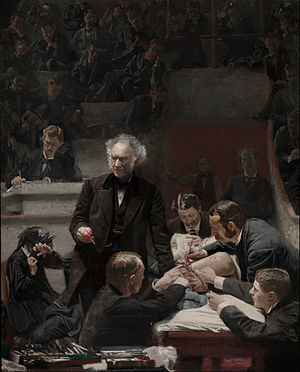The Gross Clinic
| The Gross Clinic | |
|---|---|
 |
|
| Artist | Thomas Eakins |
| Year | 1875 |
| Medium | oil on canvas |
| Dimensions | 240 cm × 200 cm (8 ft × 6.5 ft) |
| Location | Philadelphia Museum of Art and the Pennsylvania Academy of Fine Arts |
The Gross Clinic, or, The Clinic of Dr. Gross, is an 1875 painting by American artist Thomas Eakins. It is oil on canvas and measures 8 feet (240 cm) by 6.5 feet (200 cm).
Dr. Samuel D. Gross, a seventy-year-old professor dressed in a black frock coat, lectures a group of Jefferson Medical College students. Included among the group is a self-portrait of Eakins, who is seated to the right hand side of the tunnel railing with a white cuffed sleeve sketching or writing. Seen over Dr. Gross's right shoulder is the clinic clerk, Dr. Franklin West, taking notes on the operation.
Eakins's signature is painted into the painting, on the front of the surgical table.
Admired for its uncompromising realism, The Gross Clinic has an important place documenting the history of medicine—both because it honors the emergence of surgery as a healing profession (previously, surgery was associated primarily with amputation), and because it shows us what the surgical theater looked like in the nineteenth century.
The painting is based on a surgery witnessed by Eakins, in which Gross treated a young man for osteomyelitis of the femur. Gross is pictured here performing a conservative operation as opposed to an amputation (which is how the patient would normally have been treated in previous decades).
Here, surgeons crowd around the anesthetized patient in their frock coats. This is just prior to the adoption of a hygienic surgical environment (see asepsis). The Gross Clinic is thus often contrasted with Eakins's later painting The Agnew Clinic (1889), which depicts a cleaner, brighter, surgical theater, with the participants in "white coats". In comparing the two, the advancement in understanding of the prevention of infection is seen. Another noteworthy difference in the later painting is the presence of a professional nurse, Mary Clymer, in the operating theater.
...
Wikipedia
